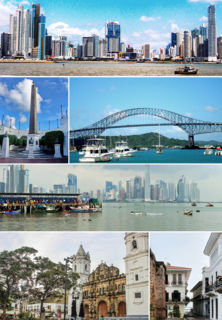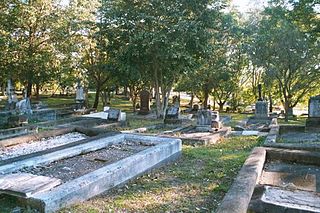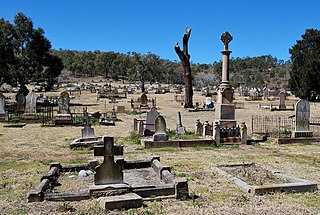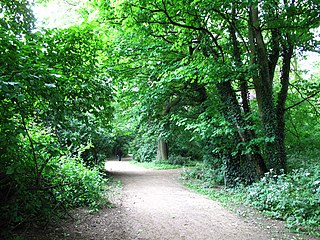Related Research Articles

Panama City, also simply known as Panama, is the capital and largest city of Panama. It has an urban population of 880,691, with over 1.5 million in its metropolitan area. The city is located at the Pacific entrance of the Panama Canal, in the province of Panama. The city is the political and administrative center of the country, as well as a hub for banking and commerce.

A cemetery, burial ground, gravesite or graveyard is a place where the remains of dead people are buried or otherwise interred. The word cemetery implies that the land is specifically designated as a burial ground and originally applied to the Roman catacombs. The term graveyard is often used interchangeably with cemetery, but a graveyard primarily refers to a burial ground within a churchyard.
World Monuments Fund (WMF) is a private, international, non-profit organization dedicated to the preservation of historic architecture and cultural heritage sites around the world through fieldwork, advocacy, grantmaking, education, and training.

The Waverley Cemetery is a heritage-listed cemetery on top of the cliffs at Bronte in the eastern suburbs of Sydney, New South Wales, Australia. Opened in 1877 and built by R. Watkins and P. Beddie, the cemetery is noted for its largely intact Victorian and Edwardian monuments. It is regularly cited as being one of the most beautiful cemeteries in the world. The cemetery contains the graves of many significant Australians including the poet Henry Lawson. It is also known as Waverley Cemetery and General Cemetery Waverley. It was added to the New South Wales State Heritage Register on 28 October 2016.

African Burial Ground National Monument is a monument at Duane Street and African Burial Ground Way in the Civic Center section of Lower Manhattan, New York City. Its main building is the Ted Weiss Federal Building at 290 Broadway. The site contains the remains of more than 419 Africans buried during the late 17th and 18th centuries in a portion of what was the largest colonial-era cemetery for people of African descent, some free, most enslaved. Historians estimate there may have been as many as 10,000–20,000 burials in what was called the "Negroes Burial Ground" in the 1700s. The five to six acre site's excavation and study was called "the most important historic urban archaeological project in the United States." The Burial Ground site is New York's earliest known African-American "cemetery"; studies show an estimated 15,000 African American people were buried here.

The Minor Basilica of San Sebastian, better known as San Sebastian Church or San Sebastian Basilica, is a minor basilica of the Roman Catholic Church in Manila, Philippines. It is the church of the parish of San Sebastian.

Undercliffe Cemetery is located between Otley Road and Undercliffe Lane in the Bolton and Undercliffe ward, Bradford, West Yorkshire, England. The cemetery stands atop a hillside overlooking the city and contains some very impressive Victorian funerary monuments in a variety of styles. It is a notable example of a Victorian cemetery where a number of rich and prominent local residents have been buried, notably mill owners and former mayors. Undercliffe Cemetery is grade II* listed by English Heritage in their Register of Parks and Gardens of Special Historic Interest in England.

Toowong Cemetery is a heritage-listed cemetery on the corner of Frederick Street and Mt Coot-tha Road, Toowong, City of Brisbane, Queensland, Australia. It was established in 1866 and formally opened in 1875. It is Queensland's largest cemetery and is located on forty-four hectares of land at the corner of Frederick Street and Mount Coot-tha Road approximately four and a half kilometres west of Brisbane. It was previously known as Brisbane General Cemetery. It was added to the Queensland Heritage Register on 31 December 2002.

Global Heritage Fund is a non-profit organization that operates internationally. Founded in California in 2002, its mission is to "transform local communities by investing in global heritage."
Corozal American Cemetery and Memorial is located approximately 3 miles west of Panama City, Panama. It is in the city of Corozal and is the location of 5,528 American veterans and others. A paved walkway leads from the Visitors' Center to a small memorial that sits atop a knoll overlooking the graves area. The memorial was established in 1923 by Congress to remember people who served overseas. It consists of a paved plaza with a 12-foot rectangular granite obelisk flanked by two flagpoles on which fly the United States and Panamanian flags.

The Fire Mummies of the Philippines, also known as the Kabayan Mummies, Benguet Mummies, or Ibaloi Mummies, are a group of mummies found along the mountain slopes of Kabayan, a town in the northern part of the Philippines. They were made from as early as 2000 BC. Today, they remain in natural caves and a museum in Kabayan.

Brandwood End Cemetery is a cemetery located in the Brandwood ward of Birmingham, England.

South Brisbane Cemetery is a heritage-listed cemetery at 21 Fairfield Road and Annerley Road, Dutton Park, City of Brisbane, Queensland, Australia, adjacent to the Brisbane River. It was built from 1870 to 1990s. It is also known as Dutton Park Cemetery. It was added to the Queensland Heritage Register on 1 October 2003.

World War I memorials commemorate the events and the casualties of World War I. These war memorials include civic memorials, larger national monuments, war cemeteries, private memorials and a range of utilitarian designs such as halls and parks, dedicated to remembering those involved in the conflict. Huge numbers of memorials were built in the 1920s and 1930s, with around 176,000 erected in France alone. This was a new social phenomenon and marked a major cultural shift in how nations commemorated conflicts. Interest in World War I and its memorials faded after World War II, and did not increase again until the 1980s and 1990s, which saw the renovation of many existing memorials and the opening of new sites. Visitor numbers at many memorials increased significantly, while major national and civic memorials continue to be used for annual ceremonies remembering the war.

The United Nations Memorial Cemetery in Korea, located at Tanggok in the Nam District, City of Busan, Republic of Korea, is a burial ground for United Nations Command (UNC) casualties of the Korean War. It contains 2,300 graves and is the only United Nations cemetery in the world. Laid out over 14 hectares, the graves are set out in 22 sites designated by the nationalities of the buried servicemembers.

Mount Morgan Cemetery is a heritage-listed cemetery at East Street, Mount Morgan, Rockhampton Region, Queensland, Australia. It was established in 1886. It was added to the Queensland Heritage Register on 21 October 1992.

The York City War Memorial is a First World War memorial designed by Sir Edwin Lutyens and located in York in the north of England. Proposals for commemorating York's war dead originated in 1919 but proved controversial. Initial discussions focused on whether a memorial should be a monument or should take on some utilitarian purpose. Several functional proposals were examined until a public meeting in January 1920 opted for a monument. The city engineer produced a cost estimate and the war memorial committee engaged Lutyens, who had recently been commissioned by the North Eastern Railway (NER) to design their own war memorial, also to be sited in York.

Hull General Cemetery was established by a private company in 1847 on Spring Bank, in the west of Kingston upon Hull, East Riding of Yorkshire, England. In 1862 the Hull Corporation established a cemetery adjacent, now known as Western Cemetery, and in c. 1890 expanded the cemetery west across Chanterlands Avenue onto an adjacent site.

The Binondo–Intramuros Bridge is an under construction bridge in Manila, Philippines that spans the Pasig River. Once completed, it will connect San Fernando Street in Binondo to Solana Street and Riverside Drive in Intramuros. The bridge will have four lanes and is planned to exhibit a steel bowstring arch design with inclined arches. It will have a length of 737 meters (2,418 ft).

The Tomb of Karl Marx stands in the Eastern cemetery of Highgate Cemetery, North London, England. It commemorates the burial sites of Marx, of his wife, Jenny von Westphalen, and other members of his family. Originally buried in a different part of the Eastern cemetery, the bodies were disinterred and reburied at their present location in 1954. The tomb was designed by Laurence Bradshaw and was unveiled in 1956, in a ceremony led by Harry Pollitt, the General Secretary of the Communist Party of Great Britain, which funded the memorial. The tomb consists of a large bust of Marx in bronze set on a marble pedestal. The pedestal is inscribed with quotes from Marx's works including, on the front, the final words of The Communist Manifesto, "Workers of all lands unite". Since its construction, the tomb has become a place of pilgrimage for followers of Marxist theory. It has also been a target for Marx's opponents, suffering vandalism, and two bomb attacks in the 1970s. It is a Grade I listed structure, the highest listing reserved for buildings and structures of "exceptional interest".
References
- ↑ "Grave cleaning day in Panama City's Chinese cemetery". The Panama News. Retrieved 14 August 2012.
- ↑ "Way On Cemetery". World Monuments Fund. Retrieved 14 August 2012.
- ↑ "GHN Sites". Global Heritage Fund. Retrieved 14 August 2012.